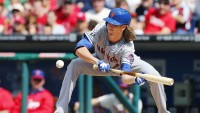NL DH Doesn’t Jive With Pace of Play Initiative

If you’ve worked anywhere, and a new boss comes in, you know they want to immediately set new things in place. They want to leave their mark. It doesn’t matter if the changes are needed or wanted. When Commissioner Rob Manfred took the helm, he set forth to improve the pace of play and average game times.
We can discuss whether the changes and/or enforcing of rules already in place was a good thing. We can debate if the changes had a noticeable impact. We can even argue if this was even necessary. That is all besides the point. What is clear, however, is that is something that the Commissioner wanted to improve.
To me, this is why the “momentum” towards adding the DH in the NL doesn’t make sense. Let’s start with the subjective. At a minimum, for innings 1-5, a National League pitcher will normally get at least two at bats. When a pitcher comes up to bat, you normally see an out. This out may be the result of the pitcher being a poor hitter. The out may be as a result of the pitcher going up there to sacrifice bunt. Regardless, the pitcher is typically a quick out. When there are quick outs, you move the game along more quickly.
Now, this quick out that helps move the game along and arguably helps improve the pace of play is replaced with a DH. As structured a DH is not an easy out. They’re typical a better hitter than the pitcher who wins the Silver Slugger. This year it was Madison Bumgarner, who hit .247/.275/.468 with five homers and 9 RBI. That’s an outlier, where you are blown over by that pitcher’s hitting stats. If you got that from a position player or a DH, you’d be screaming for them to be benched, like Evan Gattis, who hit .246/.285/.463. Side note, what was A.J. Hinch thinking last year making Gattis the DH for 136 regular season games and all six postseason games?
While it’s noteworthy that the worst DH was a better hitter than the best hitting pitcher, it’s not a complete analysis. Given that I live in the New York market, I predominantly see the Mets and Yankees play. As you may guess, I watch a lot more Mets games. In any event, in New York, the best hitting pitcher is Jacob de Grom, who hit .186/.226/.203. The Yankees normal DH was a guy you might have heard of who goes by the name Alex Rodriguez. Last year, A-Rod hit .250/.356/.486. That’s a massive difference. With A-Rod getting on base much more frequently over the position he’s replacing, the game should be longer.
However, is that necessarily true? We can think it makes the games longer, but that does not make it necessarily true. Well, it turns out AL games are typically longer than NL games. In 2014, AL games were about four minutes longer than NL games. Admittedly, four minutes may not seem like much time. However, MLB put measures in place to reduce game times, and the net result was six less minutes per game. Say what you want with respect to this, but it’s a start.
In all fairness, it does appear that the pace of play initiative had a more profound impact on the AL. The split between the NL and AL is now approximately one minute. With that said, NL games are still shorter. I’m still interested to see if: (1) MLB will continue this initiative; and (2) what the further impact this initiative has on both leagues.
However, the main point is MLB wants to shorten games. If the DH is introduced into the NL, game times will lengthen. These two concepts do not jive. As such, if MLB wants to reduce game times, it should keep the DH out of the National League.
Editor’s Note: this is the first in a series on the possibility of the NL adding the DH.